Johnny Horton
The Singing Historian
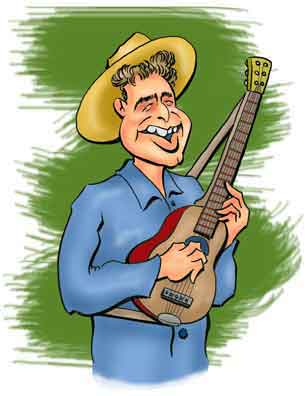
Johnny Horton
The Industry
Today with the country and western music business practically running the national economy, it's easy to forget that once upon a time it was a niche industry where the recordings rarely produced a living income for the singers. Instead, the performers had to manage from their fees from live appearances1.
Footnote
Even well-known musicians sometimes had a day job. This was particularly true for the sidemen. One of the most capable steel-guitarist would swap off playing between his usual group and another to fit his non-musical schedule.
Performances were often in small towns and improvised venues - high school auditoriums, VFW halls, local stadiums. The work could be grueling. Singers might appear in Tueplo, Mississippi on Monday, head to Sheffield, Alabama, on Tuesday, and then hit Little Rock and Camden, Arkansas, on Wednesday and Thursday only to return to Memphis for another job on Friday. On some tours they'd even have to finish a performance in McComb, Mississippi, and then head out to Cherry Spring, Texas, to play the next day - a travel distance of almost 400 miles.
Even the big names found that with such a schedule the only economical and flexible mode of transport was to drive. One hit singer used to travel with his group (which happened to be his two daughters) in a converted school bus. At one performance he quipped he had driven 1500 miles and used up 15 quarts of oil. But most of the performers traveled by car.
So it's no surprise that in even earlier days, if anyone wanted quality music, they listened to local musicians or even made the music themselves. So in 1913 after John Loly Horton married Ella Claudia Robinson in Tyler, Texas, they would sing songs and play the guitar to fill in their not too abundant free time.
John worked at everything he could from fruit picking to harvesting cotton with an occasionally branching out to civic duty when he twice served as a deputy sheriff. John's variable employment kept him and his family continuously on the move between Texas and California.
John LeGale Horton was a late arrival to John and Claudia. The youngest of five children - he had two brothers, Fred and B. F., as well as two sisters, Nora Lee and Johnnie Marie - Johnny was born in 1925 in Los Angeles since that's where his folks happened to be at the time.
The family, though, seemed to think of East Texas as their home. Gradually they began to wander less afield, and Johnny graduated from high school in the tiny town of Gallatin about 100 miles southeast of Dallas.
We have to be honest and say that without an academic biography, details of Johnny Horton's life are hard to put together. There are memories of those who knew him as well as contemporary newspaper articles. This dearth of documentation sends scholars scrambling for source material and sometimes you'll see an article having to cite album liner notes.
That said, it seems that John, Jr., was every bit as footloose as his dad. He briefly attended Baylor University but then headed with his brother, Frank, to Seattle. They enrolled at Seattle University again for a brief time (very brief, about two weeks) before bouncing down to Florida and then back to California. The usual story is that while in California Johnny worked as a commercial fisherman, and that eventually he ended up in Alaska where he (again according to the story) did some gold prospecting.
One thing Johnny had was a good singing voice. To pass the time he wrote his own songs and when he (again) returned to Texas, his sister suggested he enter a talent contest. This was sponsored by KGRI Radio in Henderson, some 30-odd miles northeast of Gallatin. Johnny won and Jim Reeves, the station's disc jockey and later a country singer in his own right, was encouraging enough that Johnny headed back to California where he began looking for a portal to turning professional.
Among the portals toward professionalism were establishments that provided bibulous refreshment to the working men and women. Music was more or less de rigueur for the patrons, and if there was no professional house band the proprietors would allow (hopefully) competent amateurs to play and sing and pass the hat. Such bars had numerous derisive names bestowed on them by the towns' proper citizens, one appellation being honky-tonks.
Johnny became one of the honky-tonk performers. The customers preferred lively toe-tapping tunes although the occasional sentimental ballad was fine. Johnny's repertoire included both and he developed a signature end-of-the-line upward falsetto glissando even in his up-tempo tunes.
It didn't take long for Johnny's singing to gain the notice of impresario Fabor Robinson. Fabor landed Johnny appearances on KXLA Radio and KCOP TV - yes, a television station. A recording contract with a small label quickly fell through and Fabor thought the best way to get Johnny on record was to establish his own company.
Fortunately, Johnny's records sold poorly. Yes, fortunately they sold poorly. Fabor managed to sell Johnny's contract to Mercury Records which, if not the biggest record company, was at a least a major player.
Johnny was a good guitar player but you really need expert instrumentalists to get the truly professional sound. So he would hire quality sidemen - or sidepersons we should say. One club called on customers to come in and see "Johnny Horton and his All Girl Band".
By 1952, Johnny had become well enough known to receive an invitation to play on Louisiana Hayride. This was a nationally syndicated radio and television program based in Shreveport. But despite the potential for reaching a good part of the American public, as was true of the Grand Ole Opry and the even more venerable National Barn Dance, the Louisiana Hayride was not tuned in by the general population.
But one thing the Hayride did was to serve as a showcase to new talent including a swivel-hipped Mississippian named Elvis Aaron Presley. If ability and logistics permitted, the most promising newcomers might land a spot on the show. Johnny soon became a regular.
Appearing on the Hayride, although a major step up, didn't provide a full time income. So Johnny continued his live appearances. The usual story is that his sobriquet "The Singing Fisherman" came from his days in commercial fishing. However, he may have been so dubbed because of his penchant for stopping on the way to a performance to fish. That drove some of the band members to distraction, and they began to let Johnny drive himself and they took their own cars.
Despite providing time to fish, driving hundreds of miles in a day got to be a drag. Soon Johnny decided to chuck show business and get a regular job. He played on the Hayride only on weekends.
In 1955 and getting fed up with seemingly going nowhere, Johnny went to Tillman Franks, a stand-up bass player who had been with the Hayride since the start. Tillman also had an uncanny business sense but balked at being Johnny's manager. When he told Johnny he just didn't like the way he sang, Johnny said he'd sing any way Tillman wanted.
It's a tribute to both Tillman's savvy and Johnny's ability that Tillman was able to land Johnny a contract with one of the biggest record companies. That was Columbia who among its producers was sing-along man Mitch Miller. In addition to being Johnny's manager, Tillman stood in on bass.
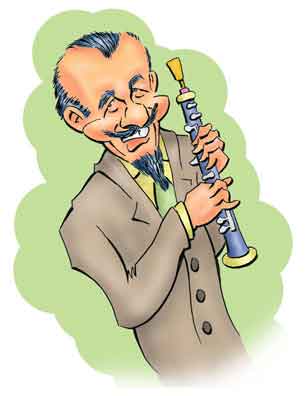
Mitch Miller
An Executive
Johnny and Tillman began writing new songs for his Columbia releases. They were of the honky-tonk genre and they consistently got Johnny onto the country charts: "Honky Tonk Man" (1956) rose to #9, and "I'm A One-Woman Man" (also 1956) reached #7. In 1957, "I'm Coming Home" hit #11, and "The Woman I Need" climbed to #7 as did "All Grown Up" in 1958.
Then in 1959 Johnny recorded "When It's Springtime in Alaska (It's Forty Below)". Penned by Tillman the song has a rather improbable plot but it was a hit and rose to the #1 spot on the country charts. Johnny had made it to the top.
A Country Interlude
We don't mean to say that country music was a minor entertainment industry. But its appeal remained regional and the more urbanized of Americans tended to look askance at songs that spoke of the virtues of driving trucks and pouring bourbon over your cornflakes2. Well into the 1950's it was commonly referred to as "hillbilly" music even by the artists themselves.
Instead it was rock and roll as championed by disc jockeys like Alan Freed that was going national. The irony is that the gyrating young man who had appeared on Louisiana Hayride and loved singing gospel music had become the #1 rock star. Rock and roll was soon being denounced by government officials, law enforcement officers, and religious leaders. A story about the consternation it was causing even appeared in Life Magazine. Country music never created such angst.
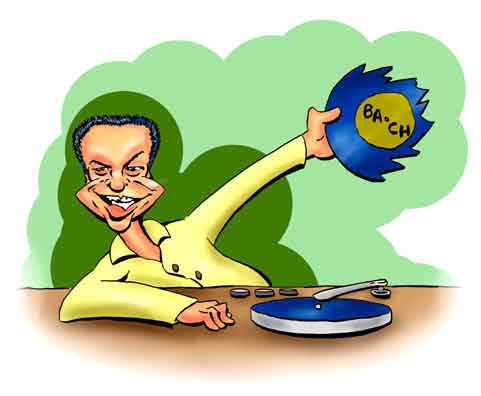
Alan Freed
Going National
Which is really amazing since any difference was often a matter of visual perception rather than objective differences in the music. Die-hard Bill Haley fans know that when Bill lived in Philadelphia he led a group of country musicians called "The Saddlemen". When on stage they sported Western garb, and they released some sides including "I'm Gonna Dry Every Tear With A Kiss", "Why Do I Cry Over You?", "Rocket 88", and "Rock The Joint".
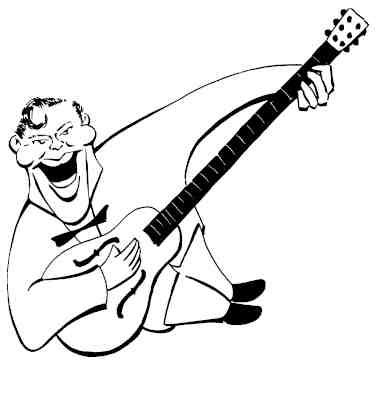
Bill Haley
He changed the name and costumes.
And yes, some of these titles not only read a lot like rock and roll songs, but if you listen to them, they sound like rock and roll. So there really wasn't much of a transition when Bill and the band doffed their country duds, put on prom suits and ties, and hey, presto!, they were "Bill Haley and His Comets".
Yet "hillbilly" music was kept in its own niche and even the songs that could double as rock and roll were called "rockabilly". Although Louisiana Hayride, the National Barn Dance, and the Grand Ole Opry boasted a large broadcast range, most country/western/hillybilly/rockabilly music was heard on local or regional stations.
Country in the City
When inroads came they were from an unusual source. From the 1930's there was what has been called the Folk Revival. City kids had been putting on work shirts and blue jeans and picking up guitars and banjos and singing "Casey Jones", "Michael Row the Boat Ashore", and "The Erie Canal". Unlike rock and roll, there was something undeniably patriotic about folk music with its celebration of the American Experience. After World War II, folk songs began finding a respectable audience on national broadcasts.
But even then the music had to be sanitized to fit popular tastes. In 1950 The Weavers, a folk group featuring Pete Seeger, Fred Hellerman, Ronnie Gilbert, and Lee Hays, reached #1 on the pop charts with the Leadbelly3 composition "Goodnight Irene". The song went on to be the #1 hit of the year.
Footnote
Huddie Ledbetter - better known as Leadbelly or Lead Belly - was a folk singer who performed professionally from the mid-1930's to 1949. He had twice served time for murder in Texas and Louisiana but was paroled. For a while he traveled with folklorist John Lomax where he performed as a part of John's lectures. He finally settled in New York City. He took "Irene" as his theme song and performed it in all his concerts. Leadbelly died in 1949 in New York City of amyotrophic lateral sclerosis (better known as Lou Gehrig's disease), a year before The Weaver's version became a hit.
People who knew Leadbelly personally and worked with him remembered his high standards of professionalism. He understood the requirements of broadcasts performances and was always on time.
There was, though, a catch. To fit the popular tastes, the music moguls felt they had to transmogrify the song to where it was scarcely folk. When the record was released The Weavers even had second billing behind the back-up orchestra of Gordon Jenkins. With the orchestra plus the added studio chorus, this treacly version leaves many a folk purists a-gagging.
Still, "Irene Goodnight" might have been the catalyst to bring country to the mainstream. But sadly the leftist politics of the "folkies" fell afoul of Non-Tail Gunner Joe McCarthy and the various congressional investigative committees. Most folk singers vanished from the airways although some like Burl Ives remained above suspicion and kept on singing.
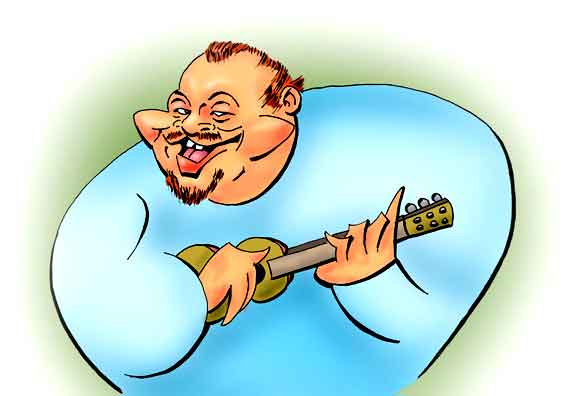
Burl Ives
He kept on singing.
It really wasn't until 1958 that three completely non-political and clean cut college kids - Dave Guard, Bob Shane and Nick Reynolds - performing as the Kingston Trio had a really big folk hit with "Tom Dooley". The song even inspired a movie starring Michael Landon (Little Joe on Bonanza and Charles Ingalls - the father - on Little House on the Prairie) although the plot fiddles with the facts quite a bit4.
Footnote
Thomas Dula was indeed a real person who was convicted for the murder of Laura Foster in Wilkes County, North Carolina. Laura was last seen on May 25, 1866, and her body was found in a shallow grave on June 18. Most suspiciously Tom fled the area but was later arrested and tried for the murder. He was executed on May 1, 1868. The story attracted widespread national interest and accounts appeared in New York newspapers.
A number of songs about the murder were written over the years. The Kingston Trio's version was essentially that of folklorists Frank and Anne Warner. They in turn had learned the song from a North Carolina farmer, carpenter, and banjo maker, Frank Proffitt.
The Kingston Trio served as a model for other 1960's squeaky clean folk groups like the Limelighters and the New Christy Minstrels (which featured a young Kenny Rogers). Because the songs tended to be quiet, harmonious, and about non-controversial topics, parents tolerated the folk groups and sometimes even enjoyed the music themselves.
Folk music had rural origins and country music now began to creep into the mainstream. In 1963, singer Jimmy Dean, capitalizing on the popularity of his tune "Big Bad John", was given his own primetime show. The Jimmy Dean Show ran from 1963 to 1966, and among other distinctions was the first television show to regularly feature Jim Henson's muppets as the gruff but genial Rowlf the Dog. Jimmy's success was followed in 1969 by the Johnny Cash Show on ABC and Glen Campbell's Goodtime Hour.
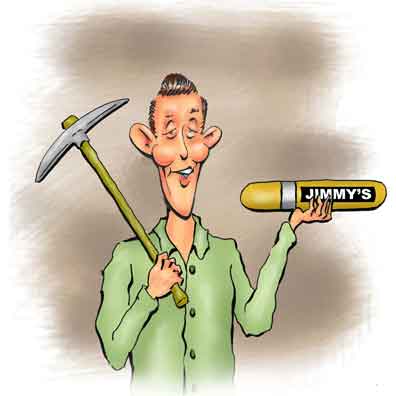
Jimmy Dean
Primetime
You can argue, though, that Johnny's and Glen's and Jimmy's shows were not really country music programs but simply mainstream variety shows5. Sure among the guest stars were country singers like Loretta Lynn, Merle Travis, and Maybelle Carter, but there were also popular musicians and comedians like Al Hirt, Pearl Bailey, Melanie, George Gobel, and Milton Berle.
Footnote
Glen, in fact, once said he didn't consider him as a country musician. Country music, he said, was "You-broke-my-heart-so-I'm-gonna-break-your-neck" which wasn't the music he sang.
Then came Hee Haw.
Hee Haw was also first broadcast in 1969. Modeled after the hippie inspired comedy sketch show Rowan and Martin's Laugh-In, Hee Haw's skits were sandwiched between musical interludes and often the twain did meet.
The humor was centered on hillbilly stereotypes - slow drawling men clad in overalls and shapeless bag hats accompanied by women in short shorts and blouses knotted up above the midriff - but the music was pure country. The co-hosts, Roy Clark and Buck Owens, represented their respective sub-genre - Buck providing the California Bakersfield "Outlaw" sound and Roy, one of the most talented multi-instrumentalists in the business, brought in the southern and eastern styles including bluegrass.
Although Hee Haw had plenty of crossover guests - Sammy Davis, Jr., Marie Osmond, Ed McMahon, Terry Bradshaw, Orville Redenbacher, Tony Orlando, Hugh Hefner, and Kathy Lee Gifford - there was no doubt that the show was for country fans. Among the guests were - and to skip the rather lengthy list just click here - Kenny Roberts, The Statler Brothers, John Ritter, Billy Joe Royal, The Kendalls, Freddy Weller, Wendy Suits Johnson, Jack Burns, John Stanley, Amanda Blake, George Hamilton IV, Dub Taylor, Tanya Tucker, Dolores Edgin, Kelly Foxton, Floyd Cramer, Susan Raye, Leon Rhodes, Naomi Judd, Tommy Cash, Chill Wills, Stan Musial, Willie Nelson, Dennis Weaver, Ray Saunders, Hester Linwood Clark, The Nashville Edition, Jeff Smith, Ricky Skaggs, Ken Kercheval, Roy Rogers, Jessi Colter, Lester Flatt, Clint Black, Skeeter Davis, Jeannie C. Riley, Dolly Parton, David Houston, Cherokee Bob, Hoyt Axton, Sunday Sharpe, Steve Gatlin, Johnny Cash, Jeannie Seely, David Ball, Dottie West, Jerry Clower, Vern Gosdin, Donna Fargo, Jed Allan, Kathie Lee Gifford, Johnny Bench, Barbi Benton, David Huddleston, Terri Gibbs, Wanda Jackson, Sandy Posey, Jimmy Dean, Freddy Fender, Patsy Sledd, Charlie Walker, Orville Redenbacher, Hugh Hefner, Margo Smith, Lynn Anderson, Merlin Olsen, Woody Woodbury, Don Lacy, Jack Ruth, Jerry Chesnut, Chet Atkins, Forester Sisters, Jerry Brightman, Mackenzie Colt, Lee Greenwood, Ruth Buzzi, Richard Petty, Bob Montgomery, Restless Heart, Billy Carter, Billie Jo Spears, Butch McCain, Connie Smith, Jim Berthiaume, Gene Watson, Connie Eaton, Mel Street, Beecher Kirby, Don Gibson, The Whites, Cale Yarborough, Ernest Borgnine, Kathy Samples, Roger Maris, Bill Blaylock, Bobby Goldsboro, Jan Howard, The Bakersfield Brass, Bobby Thompson, Ray Griff, Union Station, Jean Shepard, Willie Ackerman, Billy Dean, Big Al Downing, Judy Rodman, Tom T. Hall, Glen Campbell, Dan Seals, Rudy Gatlin, James DePaiva, Harold Bradley Jackson, Jim Ed Brown, Burl Ives, Ray Price, Duke of Paducah, John Schneider, Ray Stevens, Ray Sanders, David Frizzell, Sammi Smith, George Strait, Joe Babcock, Susie McEntire, Jeanne Pruett, Rex Allen Jr., Victoria Hallman, Catherine McKinnon, Tennessee Ernie Ford, Helen Cornelius, Stan Hitchcock, Crystal Gayle, Stan Kann, Amy Grant, Brenda Lee, Steve Wariner, Stoney Edwards, Eddie Rabbitt, Jerry Reed, Dottsy, Randy Boone, Kris Kristofferson, Boxcar Willie, Wendy Holcombe, Tammy Wynette, Kitty Wells, Billy 'Crash' Craddock, Charlie Daniels, Slim Pickens, Gary Morris, Johnny Lee, John Henry Faulk, Bill Fries, Tex Ritter, Alonzo Ward, Dwight Yoakam, John Conlee, Penny DeHaven, Ethel Merman, Vic Damone, Roni Stoneman Hemrick, Tommy Ambrose, David Holt, Bobby Bare, Karel Gott, Steve Hall, Don Williams, Sonny Shroyer, Lorrie Morgan, Jeannine Riley, Brush Arbor, Dave & Sugar, Irlene Mandrell, Sherry E. DeBoer, Peggy Little, Terry McMillan, Marie Osmond, Billy Grammer, Johnny Rodriguez, Sherry Aldridge, Suzy Bogguss, Mickey Gilley, Jimmie Rodgers, Bobby Vinton, Russell Knight, Tony Booth, Paul Clark, Danny Davis and the Nashville Brass, Patti Page, Ferlin Husky, Kingfish, Sonny James, The Wild West and Fancy, Terry Bradshaw, Henson Cargill, Dale Evans, Moe Bandy, Doug Kershaw, Marcy Cates, Jo-El Sonnier, Kenneth Trebbe, Kenny Price, Reba McEntire, Paul Overstreet, Loretta Lynn, Skip Stephenson, Buddy Alan, Larry Gatlin, Caitlyn Jenner, Mary Gordon Murray, Grady Nutt, Linda Thompson, William Price, Hank Thompson, Tom Wopat, Darrell Waltrip, Buck Trent, Jim Shaw, Travis Tritt, Mel McDaniel, Jody Miller, Hank Snow, Sawyer Brown, Sammy Jackson, Sons of the Pioneers, Louise Mandrell, The Buckaroos, Johnny Duncan, Charlie Rich, Eddy Fukano, Hank Williams Jr., B.J. Thomas, Jamey Ryan, Phil Harris, Richard Roberts, Linda Martell, Ed Bruce, June Carter Cash, Mike Snider, Bobby Murcer, Charly McClain, Ronnie Milsap, Demetris Tapp, Leslie Nielsen, Ralph Emery, John Hiatt, Jean Martin, Gail Davies, Diana Goodman, George Gobel, Paul Anka, Linda K. Lance, Janie Fricke, George Jones, Linda Ronstadt, Kristine Arnold, Razzy Bailey, Ricky Van Shelton, Charlie McCoy, Stan Freese, Jud Strunk, LaWanda Lindsey, Dale Robertson, Johnny Bush, Rudolf Wanderone Jr., Carroll Baker, Janis Oliver, Rodney Lay, The Oak Ridge Boys, Keith Stegall, Willard Scott, Donna Douglas, Kathy Mattea, Charlie Cullins, Craig Scott, Ernest Rey, Hervé Villechaize, Barbara Fairchild, Bill Anderson, Wayne Massey, Jerry Lee Lewis, Randy Travis, Earl Thomas Conley, Jerry Jeff Walker, Eddy Raven, Ruby Davis, Lorianne Crook, Dudley Clark, Tommy Overstreet, Wynonna Judd, Shelly West, J.T. Jackson, Shelby Lynne, Conway Twitty, Sherry Bryce, Ray Charles, Paul Williams, John Farley, Kenni Husky, Larry Gatlin & The Gatlin Brothers, Molly Bee, Hurshel Wigington, Anne Randall, Frankie Laine, Ben McCain, Ernest Tubb, Jennifer Bishop, Robin Leach, T.G. Sheppard, Earl Dickerson, Freddie Hart, Bill Taylor, Will Geer, K.T. Oslin, Arlene Harden, Mary Taylor, Riders in the Sky, Vicki Bird, Jonathan Winters, Joe Higgins, Charley Pride, Paul Richey, John Anderson, Porter Wagoner, Kyle Petty, Gamble & More, Sheb Wooley, Sue Thompson, Jim Stafford, Merle Travis, Harry Cole, T. Graham Brown, Marty Robbins, Aaron Tippin, Lionel Cartwright, Ava Barber, Waylon Jennings, Keith Whitley, Sheila Aldridge, Faron Young, The Dillards, Mary Chapin Carpenter, R.C. Bannon, Merle Haggard, Jana Jae, Larry Mahan, Diana Trask, Stella Parton, Patti Roberts, Doyle Holly, Red Steagall, Garth Brooks, Kenny Rogers, Eugene Fodor, Ramona Jones, O.B. McClinton, Barbara Mandrell, Dizzy Dean, Alan Jackson, Mel Tillis, James Bacon, Regis Philbin, Mickey Mantle, The Hee Haw Band, Vernon Presley, Leona Williams, Sammy Davis Jr., Marty Stuart, Joe Stampley, Pat Boone, Tony Orlando, Margie Cates, Roy Acuff, Jim Varney, John Hartford, Mac Wiseman, Alison Krauss, Red Shipley, Stonewall Jackson, Tommy Lasorda, Ed McMahon, Roger Miller, Rex Allen, Audrey Landers, Charlie Chase, Jay McDonald, Bonnie Owens, Johnny PayCheck, and Conny Van Dyke.
[To return to the beginning of the list click here.]
Then almost immediately the show was cancelled. Not because it wasn't popular - it was. Not that it didn't attract a diverse audience - city people liked it as much as those in the rural areas. But it was simply that the network bigwigs decided to purge the airwaves of anything with a rural theme. Long time favorites toppled: Green Acres, The Andy Griffith Show (then called Mayberry, RFD), Petticoat Junction, and that included the Beverly Hillbillies.
When we said everything we mean everything. Even animal shows like Mutual of Omaha's Wild Kingdom were canceled, for crying out loud! What the hey was going on?
Remember it was the moguls who did the canceling. It seems that fans of country music and animal lovers weren't the type of viewers that the advertisers thought would spend vast amounts of money on products they neither needed nor wanted. So the programs were tossed.
Fortunately many of the shows went into syndication. Wild Kingdom returned and kept on until 1986. Hee-Haw thrived as well, ultimately being in continous production for 25 seasons6.
Footnote
It wasn't only country shows that fell to the executives' ax. Any show that didn't appear to young people whose parents had deep pockets were dropped. It didn't matter if the ratings were high, if it was popular with frugal viewers then the show as cut. That included the long running Lawrence Welk Show.
Larry and the producers simply formed their own company and went into syndication. So the individual stations could opt to show them or not. If anything the had more viewers than ever and kept going until 1982.
It can be argued that the massive purge based on perceived advertisement revenues was the beginning of the end of the monopoly of the Big Three Networks. Since so many shows went into syndication, it became clear that specialized independent companies could compete. With cable television just over the horizon the Big Three soon were sitting in the back seat.
Hee-Haw was also popular with the kids and it's probably no coincidence that shortly after it went into syndication came a true breakthrough in country music. In 1972 the Nitty Gritty Dirt Band released their album Will the Circle Be Unbroken which featured big name country guest stars like Roy Acuff and Earl Scruggs. Suddenly it was cool for kids to be country. Other pop stars began flipping like pancakes and Kenny Rogers and Leon Russell became country while remaining popular with the rock crowd.
The final boost toward mega-popularity of country culture came in the 1980's with the release of John Travolta's film, Urban Cowboy. Then the small sleepy town of Branson, Missouri, until then regionally known for its country themed amusement park, Silver Dollar City, boomed into national consciousness when Hee-Haw host Roy Clark opened his Celebrity Theatre. Roy himself would appear, of course, but he also brought in big name performers. More musicians opened their own theaters in Branson and Country and Western was "Hillbilly" no more.
Johnny at the Top
Given the slow and tortuous path that country music had to take, it's no surprise that the winner of the first Grammy Award for Best Country Record was scarcely country. The award went to "Tom Dooley" by the Kingston Trio. It wasn't until the 3rd Grammy Awards that "El Paso", a clear-cut country song performed by Marty Robbins, was so honored.
OK, we now know who won the first and third awards for the Best Country Record. What about the 2nd?
In 1936 an Arkansas high school principal named James Corbitt Morris decided if he wrote songs about history the kids might get more interested in their studies. Born in 1907, Jimmy himself never got beyond the eighth grade, but he managed to get admitted to the Arkansas State Teachers College (now the University of Central Arkansas). He didn't complete a degree but passed the teachers examination which at the time qualified him to teach in the public schools.
Jimmy Driftwood - Mr. Morris's musical nome de plume and derived from a prank played by his grandad - wrote a song about the Battle of New Orleans. This was the famous confrontation in the War of 1812 where an army under Andrew Jackson - "Old Hickory" - defeated the British under the command of Sir Edward Pakenham at the plantation owned by Ignace de Lino de Chalmette. Of course we read that the war had already ended but the battle still made Andy a hero7.
Footnote
Strictly speaking the battle was not fought before the war was over as is often stated. The battle was fought on January 8, and The Treaty of Ghent ending the war was ratified by the United State Senate on February 16, 1815. The war officially ended the next day.
The cause of the confusion is the treaty was signed the previous Christmas Eve. So you can say that, yes, hostilities had officially ended when Andy and Colonel Pakenham met in New Orleans. On the other hand the news traveled so slowly that there was a naval engagement as late as June, 1815.
Setting the words to the old fiddle classic "The Eighth of January", Jimmy made sure to include historical details:
Well, I seed Mars Jackson a-walkin' down the street
And a-talkin' to a pirate by the name of Jean Lafitte.
He gave Jean a drink that he brung from Tennessee,
And the pirate said he'd help us drive the British in the sea.
The lyrics also mentioned the fate of the British commander:
The guide who brung the British from the sea
Come a-limpin' into camp just as sick as he could be,
He said the dying words of the Colonel Pakenham
Was, "You better quit your foolin' with your cousin Uncle Sam."
Jimmy continued to write songs and became a central figure in organizing Ozark folk festivals where he would often perform. Once the folk music revival was in full swing it was natural that he'd record some of his songs. His first album was "Newly Discovered Early American Folk Songs" in 1958. The first track was the "Battle of New Orleans".
Johnny heard the song and wanted to record it. But in the day when there were more than seven words you couldn't say on the radio he saw some problematical verses.
The French told Andrew, "You'd better run
For Pakenham's a-comin' with a bullet in his gun."
Old Hickory said he didn't give a 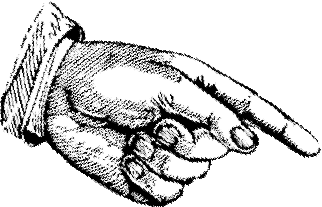 damn.
damn.
He's a-gonna whup the britches off of Colonel Pakenham.
... and ...
Old Hickory said we'd take 'em by surprise
If we didn't fire a musket till we looked 'em in the eyes.
We held our fire till we seed their faces well.
Then we opened up our squirrel guns and really gave 'em  hell.
hell.
The first verse was simply cut out. The last verse was handled with a humorous bowdlerization:
We held our fire till we seen their face well.
Then we opened up our squirrel guns and really gave 'em ...  Well.... we...
Well.... we...
Chorus:
Fired our guns and the British kept a comin'...
Johnny's version became one of the biggest hits ever. It rose to #1 in the country charts where it stayed for 10 weeks. But it also hit the #1 on the pop charts - the big pop charts - the really big pop charts - where it remained for 7 weeks.
The "Battle of New Orleans" won Johnny the Grammy Award for Best Country Song for 1960 and the Song of the Year for Jimmy as the composer. Kids loved the song and would sing it on playgrounds, at parties, and on picnics. The record went gold and kept on selling.
Johnny, until then known mostly to country fans, was suddenly an international star. He immediately put out an album with other history themed songs: "Johnny Freedom", "Jim Bridger", "Commanche (The Brave Horse), "Snow-Shoe Thompson", "O'Leary's Cow", "John Paul Jones", "Young Abe Lincoln (Make a Tall, Tall Man)", "The Battle Of Bull Run", "The Sinking Of The Reuben James", "(You Fought All the Way) Johnny Reb", "Sink The Bismarck", and of course "The Battle Of New Orleans". Five of the songs were released as singles and "Sink The Bismarck" was particularly popular, climbing to #6 on the country charts and #3 on the pop.
Johnny hit the television shows, and we have to admit that some of his appearances heralded today's lamentable music videos. Dressed in a Civil War Union uniform, he sang "Johnny Reb" sitting next to an actor in Confederate garb. On the Eddie Arnold Show, Johnny appeared in what may be considered a passable but nondescript cavalry uniform to sing "Comanche the Brave Horse". Afterwards Johnny joined Eddy and Molly Bee for a trio which, we must admit, was really a much better song.
But it was on the Ed Sullivan Show that Johnny put on a really big shew. Decked out in an all white Davy-Crockett outfit (including the raccoon-tailed cap) accompanied by similarly accoutered Tillman on bass and Gerald "Tommy" Tomlinson on guitar, Johnny sang the song with a complex - but we must admit expertly performed and quite acrobatic - choreographed dance troupe.
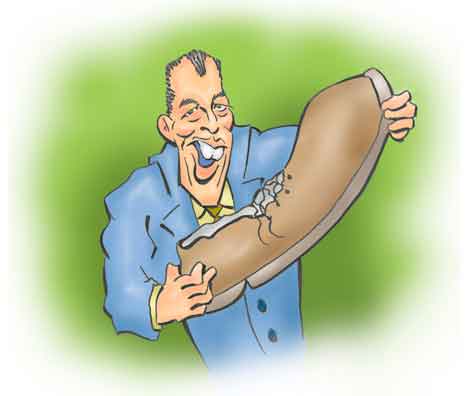
Ed Sullivan
Johnny put on a really big shew.
Contrary to popular memory, "Sink The Bismarck" was not featured in the eponymous English produced motion picture. But in the American theaters the song was played over the preview trailers. The connection of the song with the movie brought Americans to the theaters and the movie did quite well.
But... but.... people ask. Why wasn't Johnny's hit "North to Alaska" on the album? The song went to #1 on the country charts and #4 on the pop. Here Johnny sings about Sam McCord ("a mighty man in the year of nineteen-one") who went gold prospecting in Alaska with "George Pratt his partner" and "Brother Billy, too". It was a great story and a great title song for the movie of the same name.
The movie starred John Wayne as Sam, Stewart Granger as George, Fabian Forte as brother Billy, and was released in late 1960. With the song coming on the heels of the slew of Johnny's history songs, it was natural for people to believe that there really was a Sam McCord who really was a mighty man in the year of nineteen-one.
Alas, the story - and the movie - was complete fiction.
The success of the "Battle of New Orleans" was too great to be confined by geo-political boundaries. England's skiffle musicians like Lonnie Donegan had embraced the folk tradition and sang the song with gusto. Naturally Johnny's own version had to be released worldwide.
But there was one wee little problem.
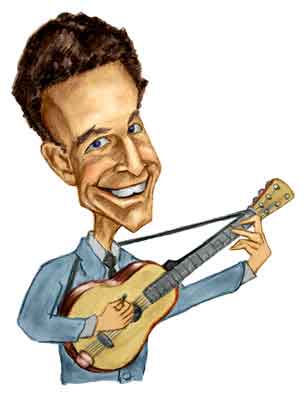
Lonnie Donnegan
Putting on the tradition.
It wasn't just that in England the word "bloody" had the force of a swear word8.
Footnote
As late as the 1960's a book by an English author wrote the word as "bl--dy".
We fought the bloody British ....
... but remember that the song celebrates a British defeat:
They ran so fast that the hounds couldn't catch 'em
On down the Mississippi to the Gulf of Mexico.
So how could Johnny sing to the English about the virtues of Old Hickory whuppin' the English?
Well, never underestimate Yankee ingenuity. If Johnny could tweak Jimmy's original lyrics to meet mainstream American sensibilities, then he could extend the same courtesy to our cousins across the sea.
So in the United Kingdom and the British Commonwealth, listeners heard Johnny belt out:
In eighteen-fourteen we took a little trip
Along with Colonel Packingham up the Mississipp.
We took a little bacon and we took a little beans
And we met the bloomin' rebels in a town in New Orleans.
With a few other changes, the rest of the song was pretty much the same.
A number of writers have pointed out the irony that after country singer Hank Williams died while traveling in a car that Johnny married his widow, Billie Jean, who was to be widowed again when Johnny himself was killed in a car crash.
However, Hank was not killed in a car wreck although some people assume he was. Instead he was being driven to a concert. Sitting in the back seat he most likely succumbed from a heart attack brought on by an effect of alcohol and prescription drugs.
On November 5, 1960, Johnny had finished a show at the Skyline Club in Austin, Texas. Johnny was driving his car on the railroad overpass in Milano when his car was hit head on by a pick-up truck. Tillman was sitting in the passenger's seat and Tommy was in the back.
The driver of the truck was a 19-year-old student of Texas A&M University, James Davis. He was intoxicated at the time and had crossed three feet across the middle of the road. Johnny's Cadillac was knocked back 300 feet and completely demolished.
Johnny died before the ambulance reached the hospital. Tommy's leg's were seriously injured and one later had to be amputated. Tillman recovered and remained active in the music industry. He lived until 2006.
So why did the news stories of Johnny's death end up relegated to the depths of the papers. It was on page 40 of the Chicago Tribune and the last page in local publications.
Remember we are talking about 1960. Country music was still held somewhat in disdain. News of movie and television stars was worthy of Page One Headlines, yes, but not country musicians.
You'll read that Johnny had premonitions of his death - that he would be killed by a drunk and in a car crash. Tillman discounted such predictions. He did say Johnny worried he would might die early and violently - maybe a plane crash (as had happened with rock and roll star Buddy Holly) - but his worries weren't as detailed as the after-the-fact prophecies.
James Davis was tried for murder without malice. The non-jury trial lasted thirty minutes. Pleading nolo contendere he received two years probation and had his driver's license suspended for six months That story made the front page.
The Return of Johnny Horton
Within a year of his death Columbia released Johnny Horton's Greatest Hits which sold quite well. Other retrospective albums followed but by the end of the decade it was getting harder to find Johnny in the bins at the record stores9. Most of his songs were out of print by the 1970's and the last major release by Columbia was in 1971 as a two record set The World of Johnny Horton.
Footnote
The great irony is that today the only record stores left are those that have returned to the thrilling days of yesteryear and sell the old fashioned vinyl recordings. So you might indeed find Johnny Horton records in their bins.
But with the rise of the digital age, and the dissemination of the compact disc, albums that people thought would never air again popped up everywhere. New collections were crafted and bins with Johnny's songs returned including Johnny Horton Makes History.
But diehard Johnny Horton fans are returning to celebrating his early honky-tonk and rockabilly songs as his true legacy. The saga songs, for all their popularity, must needs have be considered, yes, pop or even - dare we say it? - "novelty tunes".
I mean, "The Battle of New Orleans", "Sink the Bismark", or "North to Alaska" compared to "Take Me Like I Am", "I Don't Like I Did", "Everytime I'm Kissing You", "I'm Coming Home", "Ever Loving You", "Broken Hearted Gypsy", "Tell My Baby I Love Her", "No True Love", "Sugar Coated Baby", "Move Down The Line", "Goodbye Lonesome", "Hello Baby Doll", "She Knows Why", "Devil Made A Masterpiece", "Hooray for a Little Difference", "I'll Do It Everytime", "No True Love", "I Don't Like I Did", and of course "Honky Tonk Man"?
No comparison.
References and Further Reading
The Encyclopedia of Country Music, Paul Kingsbury (Editor), Emmy Lou Harris (Foreward), Oxford University Press, 1998.
"Johnny Horton", Handbook of Texas Music, Patrick Huber (Editor), Laurie Janinski (Editor), Texas A&M Press, 2012.
"Johnny Horton", Jill Seeber , Texas State Historical Society, June 15, 2010, October 1, 2015.
"Johnny Horton", Rockabilly Hall of Fame, October 14, 2004.
"Johnny Cash Performances", Johnny Cash Live Recordings.
Room 101, Paul Merton (Presenter), Rich Hall (Guest), January 15, 2001, Internet Movie Data Base.
"How the Louisiana Hayride Captured the Evolution of Country and Rock", Stephen Thomas Erlewine, Rolling Stone, Louisiana Entertainment, December 22, 2017.
Hee-Haw, Internet Movie Data Base.
"Rock 'n Roll: A Frenzied Teen-age Music Craze Kicks Up a Big Fuss", Life Magazine, pp. 166 - 168, April 18, 1955.
"The Death Penalty: Shocking Revelations of Crime and Depravity in North Carolina - Thomas Dula Hanged for the Murder of Laura Foster", The New York Herald, May 2, 1868, Page 7, Chronicling America, Library of Congress.
The Hank Williams Reader, Patrick Huber (Editor), Steve Goodson (Editor), and David Anderson (Editor), Oxford University Press, 2014.
"Jimmy Driftwood (1907 - 1998)", Encyclopedia of Arkansas Music, Butler Center Books, The Butler Center for Arkansa Studies, University of Arkansas Press, 2013.
The Virgin Encyclopedia of Popular Music, Colin Larkin, Virgin Publishing, 1998.
"Crash Kills Horton, Top Western Singer", Long Beach Telegram, Colin Larkin, Virgin Publishing, 1998.
"Jimmy Driftwood", Discogs.
"Hank Williams' Last Ride: Driver Recalls Lonesome End", Jim Tharpe, Atlanta Journal-Constitution, December 30, 2002, Reprinted Online: July 2, 2013.
North to Alaksa, John Wayne (Actor), Stewart Granger (Actor), Fabian Forte (Actor), Ernie Kovacs (Actor), Henry Hathaway (Director), (Los Angeles, California), John Lee Mahin (Screenwriter), Martin Rackin (Screenwriter), Claude Binyon (Screenwriter), Ladislas Fodor (Playwright), John Kafka (Idea), Twentieth Century Fox, November 3, 1960, Internet Movie Data Base.
Martyn Green's Treasury of Gilbert & Sullivan, Martyn Green, Simon and Schuster, 1961.
"Tillman Franks, Sr.", Jerry Naylor, Shreveport Times, October 27, 2006.
"Horton Rites Read in Rusk Wednesday", The [Rusk] Cherokean, Volume 112, Number 7, Thursday, August 6, 1959.
"John LeGale Horton - April 30, 1925 - November 5, 1960", Find-A-Grave, Cyndi Wiseman, December 31, 2000.
"John Loly Horton - January 31, 1889 - August 3, 1959", Find-A-Grave, Cyndi Wiseman, November 9, 2010.
"Ella Claudia Robinson Horton - July 6, 1892 - December 19, 1966", Find-A-Grave, Cyndi Wiseman, November 9, 2010.
"Tillman Franks - September 29, 1920 - October 26, 2006", Find-A-Grave, John Andrew Prime, Oct 26, 2006.
"Johnny Horton", Wikipedia. Although Wikipedia has oft times been criticized for it's articles-by-committee approach, this article is one of the more comprehensive about Johnny although it has been flagged for needing more references.
"Johnny Horton The Singing Fisher Man and His All Girl Band", The Baytown [Texas] Sun, Volume 33, Number 118, Tuesday, October 21, 1952, p. 2, The Portal to Texas History, University of North Texas.
The War of 1812: A Forgotten Conflict, Donald Hickey, University of Illinois Press, 1990.
"Johnny Horton Tribute Friday", Jeanne Williams, Temple Daily Telegram, October 31, 2010.
"Trial of Aggie Student Opened", Breckenridge [Texas] American, Volume 41,Number 138, Tuesday, March 14, 1961, p. 3, Portal to Texas History, University of North Texas.
"Sentence Probated for Davis: Murder Conviction Quickly Returned", Bill Cooke, Rockdale [Texas] Reporter, Volume 89, Number 10, Thursday, March 16, 1961, p. 1, Portal to Texas History, University of North Texas.
Baytown [Texas] Sun, Volume 33, Number 118, Tuesday, October 21, 1952, p. 2, The Portal to Texas History, University of North Texas.
Taylor [Texas] Daily Press, Volume 47, Number 118, Monday, November 7, 1960, p. 1, 9, The Portal to Texas History, University of North Texas.
The Ed Sullivan Show, Ed Sullivan (Presenter), Johnny Horton (Guest), CBS, May 1, 1960.
"100 Greatest Country Artists of All Time", David Browne, Jon Dolan, Jon Freeman, Chris Parton, Stephen L. Betts, Andrew Leahey, Joseph Hudak, Kory Grow, Marissa R. Moss, Maura Johnston, Joe Levy, Will Hermes, David Cantwell, Jonathan Bernstein, Rolling Stone, June 15, 2017
"Johnny Horton", Country Music: The Encyclopedia, Irwin Stambler and Grelun Landon, Macmillan, 1997.
Jimmie Driftwood Sings Newly Discovered Early American Folk Songs, Victor RPM 1635, 1958.
Jim Reeves: His Untold Story, Larry Jordan, Page Turner Books, 2011.
"Martyn Green's Treasury of Gilbert and Sullivan", Martyn Green (Editor and Annotator), Simon and Schuster, 1961.